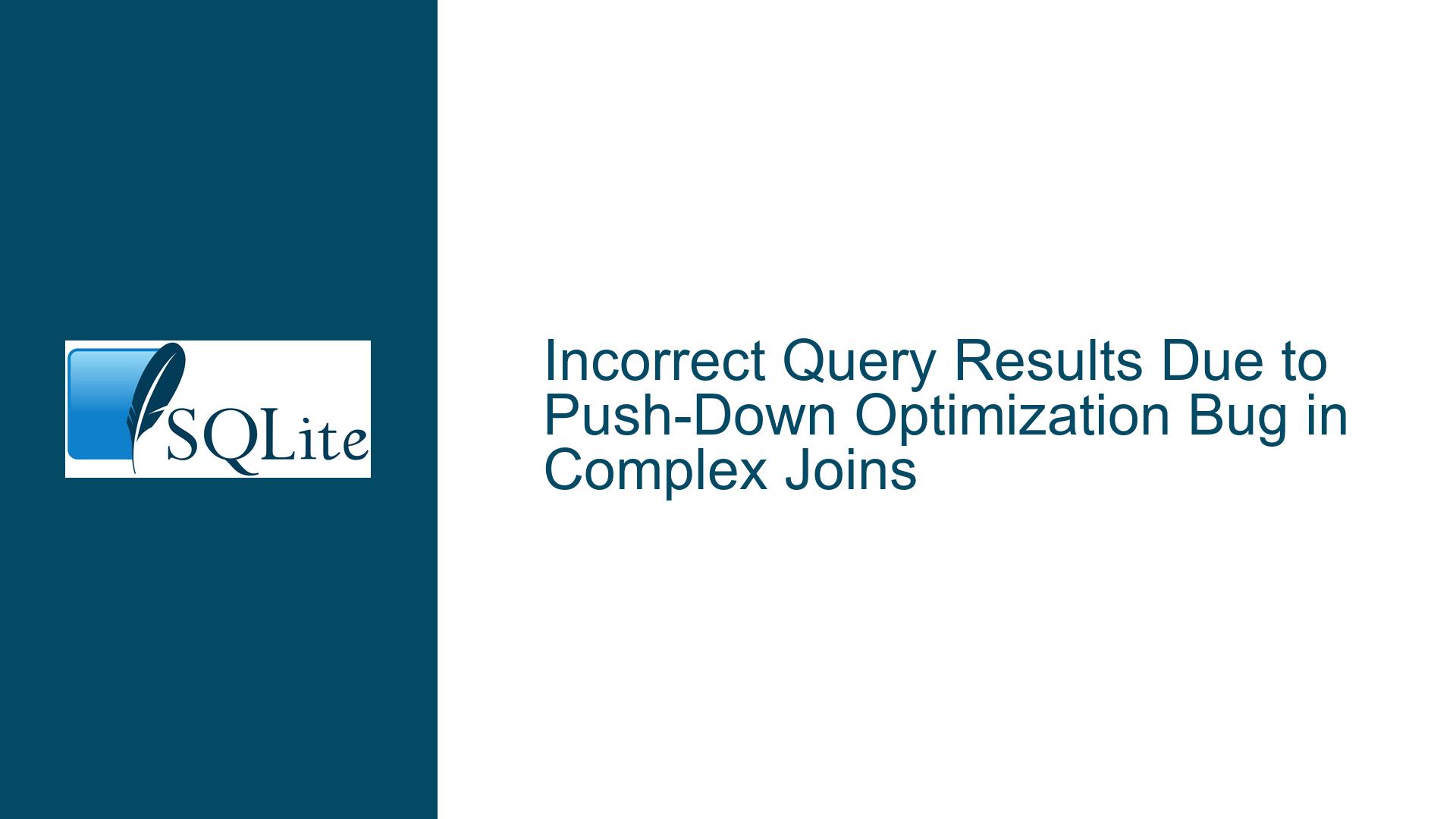Incorrect Query Results Due to Push-Down Optimization Bug in Complex Joins
Issue Overview: Complex Join Structures Yield Inconsistent Rows When Window Functions or Constants Are Used
The core problem arises when executing SQL queries involving multiple joined tables with specific optimizations applied. A combination of RIGHT OUTER JOIN, CROSS JOIN, and subqueries with ORDER BY clauses interacts unexpectedly with SQLite’s internal optimizations, particularly the "push-down" optimization. This interaction causes queries that should logically return identical results (e.g., when replacing a window function with a constant) to produce different row counts (0 rows vs. 1 row in the original test cases).
Key Components of the Failure Scenario:
Table Structure:
t1,t2,t3are base tables with a single integer columnpkey.t4and viewv5are introduced in later test cases to demonstrate the issue’s generality.- Views with
DISTINCT(likev5) prevent query flattening, forcing the push-down optimization to act on them.
Join Logic:
- INNER JOIN with
ON (false)betweent2andt3creates an empty intermediate result. - RIGHT OUTER JOIN with
ON (true)preserves all rows fromt1(right side) regardless of the left side’s emptiness. - CROSS JOIN with a subquery containing
ORDER BYintroduces a dependency on sorting, even when all columns areNULL.
- INNER JOIN with
Expression Ambiguity:
- The
CASE WHEN (true) THEN 1 ELSE RANK() OVER (...)expression should always evaluate to1, making its replacement with a constant1logically equivalent. However, the mere presence of the window functionRANK()alters how the query optimizer processes joins.
- The
Push-Down Optimization Failure:
SQLite attempts to pushONclause constraints (likefalse) from outer joins into subqueries or views that cannot be flattened. This erroneously restricts data flow in parts of the query where constraints should not apply, causing missing rows.
Symptom Manifestation:
- Test Case 1: Returns 0 rows because the push-down optimization incorrectly propagates the
ON (false)constraint from thet2-t3join into later parts of the query, effectively nullifying theCROSS JOINwithsubq_0. - Test Case 2: Returns 1 row because the simplified expression (
1) avoids triggering the push-down optimization, allowing theCROSS JOINto operate as intended.
Possible Causes: Optimization Misapplication in Join Reordering and Constraint Propagation
1. Incorrect Push-Down of Join Constraints
The push-down optimization is designed to move WHERE clauses and ON constraints into subqueries or views to limit the number of rows processed early. However, when applied to RIGHT OUTER JOIN or CROSS JOIN structures, it may violate join semantics by:
- Pushing a constraint meant for the left side of a RIGHT JOIN into the right side’s processing pipeline.
- Applying constraints to subqueries that should remain unaffected due to their position in the join order.
2. Window Functions Altering Optimization Eligibility
Even though the RANK() window function in the CASE expression is never executed (due to true making the ELSE clause unreachable), its presence changes the query’s optimization eligibility. Window functions often disable certain optimizations (e.g., query flattening) because they require ordered processing. This creates a discrepancy between queries that look logically identical but have different optimization paths.
3. Join Reordering with Empty Intermediate Results
The INNER JOIN on (false) between t2 and t3 produces an empty result. SQLite’s optimizer might:
- Short-circuit the evaluation of subsequent joins, assuming no rows will flow through.
- Miscompute the cardinality of the RIGHT OUTER JOIN, incorrectly propagating emptiness to other parts of the query plan.
4. View Flattening Restrictions
Views containing DISTINCT (like v5) or GROUP BY cannot be flattened into the outer query. This forces the optimizer to handle them as black boxes, increasing the likelihood of push-down errors. Constraints meant for upstream joins leak into the view’s execution, artificially restricting its output.
Troubleshooting Steps, Solutions & Fixes: Diagnosing and Resolving Push-Down Errors in Join-Heavy Queries
Step 1: Verify SQLite Version and Patch Status
- Check SQLite Version:
RunSELECT sqlite_version();to confirm the version is 3.42.0 or newer. Versions prior to the 2023-05-10 patch contain the push-down optimization bug. - Apply the Fix:
Update to a version that includes check-in da3fba18742b6e0b, which corrects the constraint propagation logic in push-down scenarios.
Step 2: Simplify the Query to Isolate the Optimization Trigger
- Remove Window Functions:
Replace non-essential window functions with constants or simple expressions to see if result consistency improves. This identifies whether the optimization discrepancy is tied to window function presence. - Disable Specific Optimizations:
Use pragmas likePRAGMA optimize=0x00000;to selectively disable push-down (0x00010000) or join reordering (0x00000002). Compare results with optimizations on/off.
Step 3: Analyze the Query Plan for Constraint Misplacement
- Generate the Query Plan:
PrependEXPLAIN QUERY PLANto the problematic query to visualize how joins are reordered and constraints are applied. - Look For:
- Constraints (
ON false) appearing in unexpected parts of the plan, especially within subqueries or views. - RIGHT JOIN converted to LEFT JOIN due to reordering, altering constraint applicability.
- Constraints (
Step 4: Rewrite the Query to Bypass the Push-Down Optimization
- Materialize Subqueries Early:
UseWITHclauses or temporary tables to force subquery execution before joins, preventing constraint push-down:WITH subq_0 AS ( SELECT ref_5.pkey AS c0, NULL AS c1, NULL AS c2, NULL AS c3, NULL AS c4, NULL AS c5 FROM t1 AS ref_5 ORDER BY c0 ASC ) SELECT ... FROM subq_0 ...; - Use
LEFT JOINInstead ofRIGHT JOIN:
Rewrite the query to avoid RIGHT OUTER JOIN, which is less commonly optimized and more prone to push-down errors:SELECT ... FROM t1 LEFT JOIN (t2 JOIN t3 ON false) ON true ...
Step 5: Force Consistent Empty Set Handling with COALESCE
- Wrap Join Results in
COALESCE:
Explicitly handle potential nulls from empty joins to prevent optimization-induced omissions:SELECT COALESCE(ref_0.pkey, 0) AS pkey ...
Step 6: Report and Test Against Edge Cases
- Minimize the Test Case:
Create a self-contained script that reproduces the issue with minimal tables/joins, as seen in Richard Hipp’s simplified example. This aids in debugging and communication. - Validate Fixes with Edge Cases:
After applying patches or workarounds, test queries with:- All permutations of empty/non-empty tables.
- Mixed
INNER JOIN,LEFT JOIN, andCROSS JOINstructures. - Subqueries containing
ORDER BYwithoutLIMIT, which can trigger sorting optimizations.
Final Solution: Update SQLite and Restructure Queries for Optimization Safety
- Apply the Official Patch:
The root cause is fixed in SQLite’s source code; updating is the most reliable solution. - Adopt Optimization-Resilient Patterns:
- Avoid mixing RIGHT JOIN with complex subqueries or views.
- Use
WITHclauses to materialize intermediate results. - Prefer explicit
LEFT JOINoverRIGHT JOINfor better optimizer behavior.






